Production by species group
The total volume of production, as seen in figure 1, increased from 231,582 tonnes in 200001 to 275,972 tonnes in 200304, and peaked at 279,099 tonnes in 200405.
After falling considerably in 200506, the volume of Australian fisheries production has declined gradually at a rate of one per cent on average from 200607 to 200809, reaching 237 508 tonnes in 200809. In 200910, the volume of Australian fisheries production improved, increasing by two per cent (3615 tonnes) compared with 200809, to 241 123 tonnes.

Australian sardines accounted for the highest individual catch by volume in 200910 (40,737 tonnes, accounting for 17 per cent), followed by salmonids (31,915 tonnes, 13 per cent), prawns (27,034 tonnes, 11 per cent), oysters (14,807 tonnes, six per cent) and tuna (10,957 tonnes, five per cent).
Since 200001, the real gross value of Australian fisheries production has fallen by 31 per cent, and was A$2.18 billion in 200910 (figure 2), with the majority of the decline occurring in the period to 200405. In general, from 200001 to 200910, the production value of crustaceans and molluscs has fallen considerably, by 41 per cent ($527 million) and 40 per cent ($291.9 million), respectively. The production value of finfish has also fallen in real terms, but by a lesser amount, A$130. Six million or 12 per cent over the same period. Since 200405, the real gross value of Australian fisheries production has declined by an average of two per cent a year.
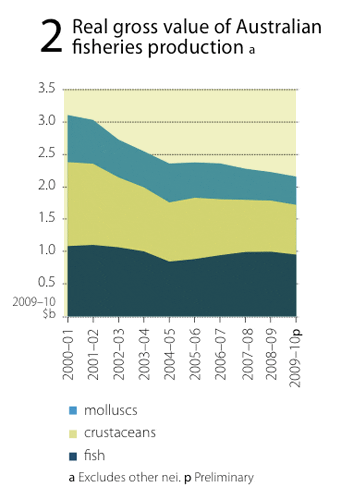
At the species group level, the decline in real value was largely driven by decreases in the value of rock lobster, prawns, abalone and tuna (figure 3). The combined value of these species groups halved in real terms from A$1.98 billion in 200001 to A$991.9 million in 200910. This represents a decline of A$986.8 million in the real value of those species groups over the period.
In the period since 200405, the decline in total value was partially offset by a significant increase in the value of salmonids exports, which increased at an average rate of 17 per cent a year, to reach A$369.1 million in 200910. The declining values of key species groups have been driven by falls in unit prices, with the exception of rock lobster (figure 4). Since production of these species is export-oriented, prices are strongly influenced by exchange rate movements.
The strength of the Australian dollar against the currencies of major trading partners, particularly the US and Japan, has reduced the competitiveness of Australian fisheries exports in recent years (box 1). Prices for rock lobster have been increasing since 200304 despite exchange rate movements, owing to increased demand for rock lobster on international markets and lower supply from key producers.
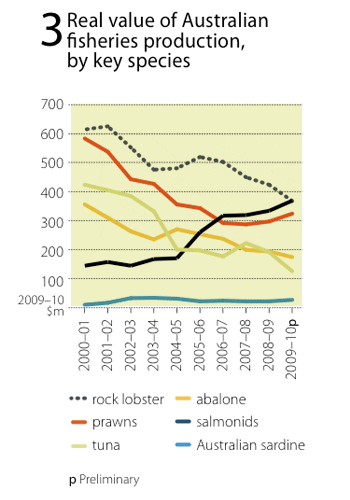
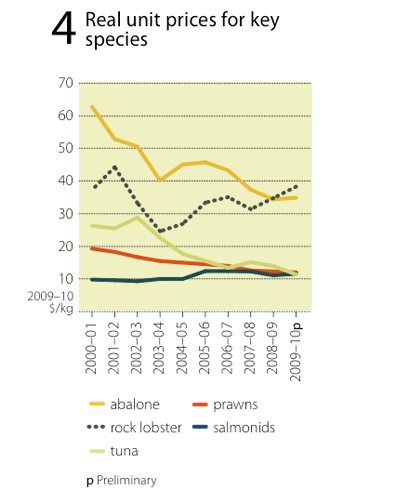
The product composition of the gross value of production of Australian fisheries has not changed substantially over the past few years. The top five fisheries products (by value) still comprise rock lobster, prawn, salmonids, abalone and tuna. Rock lobster has frequently ranked as Australias most valuable species group over the past decade.
However, salmonids surpassed rock lobster to be Australias most valuable fisheries product in 200910, at A$369.1 million, representing 17 per cent of the gross value of fisheries production. This was followed by rock lobster (A$368.8 million, 17 per cent), prawn (A$324.1 million, 15 per cent), abalone (A$173.6 million, eight per cent) and tuna (A$125.3 million, six per cent) (figure 5).
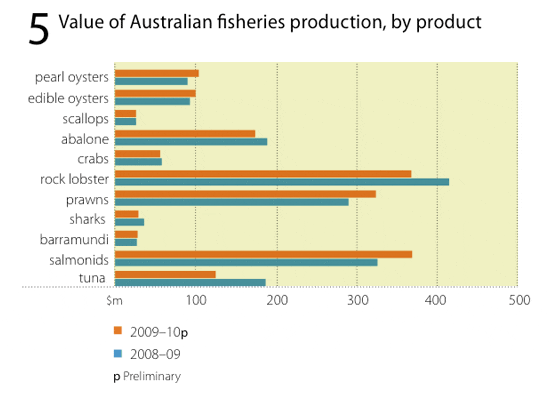
Rock lobster
Key jurisdictions: Western Australia (wild-catch (w)), South Australia (w) and Tasmania (w)In 200910, the value of rock lobster production decreased by 11 per cent (A$46 million) to A$368.8 million, following a 21 per cent decrease in the volume of rock lobster production.
Rock lobsters are caught mainly in Western Australia, South Australia and Tasmania. In 200910, rock lobster production decreased by 2575 tonnes to 9628 tonnes as a result of lower production in Western Australia, South Australia and Tasmania, which collectively accounted for 91 per cent of the Australian total volume of rock lobster production. The decline was mainly attributable to the significant decreases in production in Western Australia and South Australia. In 200910, rock lobster production from these two states combined fell by 21 per cent (1946 tonnes) from 200809 to a total of 7501 tonnes.
Western Australian rock lobster has historically accounted for a larger share (about 60 per cent on average) of the total value of Australian rock lobster production, while southern Australian rock lobster generally accounted for over 30 per cent. However, since 200304, the relative share of western rock lobster in value terms has declined compared with southern rock lobster. The share of western rock lobster in value terms fell from 65 per cent in 200304 to 50 per cent in 200910. In contrast, the share in value terms of southern rock lobster increased from 30 per cent to 45 per cent over the same period.
Between 200809 and 200910, catches of both species declined. Although western rock lobster catch fell by 22 per cent (1690 tonnes), its value of production fell by only four per cent because of a 23 per cent increase in the average beach price. Southern rock lobster catch fell by a lesser amount, 365 tonnes (10 per cent). Combined with a four per cent decrease in its average beach price, this resulted in the value of southern rock lobster production falling by 14 per cent (A$26.2 million) in 200910. Production of southern rock lobster and western rock lobster contributed A$165.5 million and A$184.1 million, respectively, to the total value of Australian rock lobster production in 200910.
Salmonids
Key jurisdictions: Tasmania (aquaculture (a))Since the start of salmon farming in 1998, salmonids production has increased significantly. Australian salmonids production has increased over the last 10 years from 14,673 tonnes in 200001 to 31,915 tonnes in 200910. This reflects a 117 per cent growth in the volume of Australian salmonids production over the period. Most of this is attributable to the strong growth of production in Tasmania, which accounts for over 95 per cent of Australias salmonids production over this period. In 200910, Australian salmonids production increased by six per cent (1879 tonnes) compared with 200809, and surpassed rock lobster to be Australias most valuable species group.
Most of Australias salmonids production occurs in Tasmania. In 200910, Tasmania produced 30,950 tonnes of salmonids, accounting for 97 per cent of Australian total salmonids production. The remaining 965 tonnes were produced in New South Wales and Victoria. The value of salmonids production rose by 13 per cent (A$43 million) in 200910 to A$369.1 million. This increase was driven mainly by a 14 per cent (A$43.2 million) increase in the value of Tasmanian salmonids production, with Tasmanias total production accounting for 98 per cent of the total value.
Tasmanian producers supply most of their salmonids to the domestic market. A key factor contributing to the rapid growth in recent years has been a strong focus on marketing salmon to Australian consumers. Additionally, the sectors strong growth has been supported by research and development, which has allowed the sector to adopt improved feeding techniques and apply better disease control measures.
Prawns
Key jurisdictions: Queensland (w, a), Western Australia (w), South Australia (w) and Commonwealth (w)In 200910, the gross value of Australian prawn production rose by 12 per cent (A$34.1 million) to A$324.1 million, following a 12 per cent (2848 tonnes) increase in the volume of production to 27,034 tonnes. Driving this was a 35 per cent increase in the production volume of aquaculture prawns (mostly in Queensland) to 5381 tonnes, valued at A$77.5 million. This value was A$20.6 million higher than the previous year.
In 200910, production of wild-caught prawns rose by seven per cent (1452 tonnes) to 21,653 tonnes, valued at A$246.6 million, which was $13.4 million higher than 200809. This was driven mainly by increases in wild-caught prawn production in Queensland and the Commonwealth prawn fisheries production, together increasing by $20.3 million. These increases offset decreases in the value of wild-caught prawn production in New South Wales, falling by A$3.8 million.
In 200910, the value of prawn production (both wild-caught and aquaculture) in Queensland increased by A$27.9 million (22 per cent) to A$155.9 million; its production volume increasing by 21 per cent. The value of prawn production in Commonwealth fisheries also increased, by A$12.9 million (16 per cent) as a result of a 10 per cent (704 tonnes) increase in production volume. This increase is largely attributable to a 15 per cent (942 tonnes) increase in the volume of prawn production in the Northern Prawn Fishery. In value terms, Northern Prawn Fishery production rose by 21 per cent (A$15.2 million) to A$88.2 million.
Abalone
Key jurisdictions: Tasmania (w, a), Victoria (w, a) and South Australia (w, a)In 200910, the volume of abalone production fell by 11 per cent, from 5612 tonnes in 200809 to 4981 tonnes, with decreases occurring in both wild-catch and aquaculture production. The value of abalone production also declined, by eight per cent (A$14.9 million) to A$173.6 million. This comprised decreases in the production value of wild-caught and aquaculture abalone, by A$7.3 million and A$7.6 million, respectively.
Most of the decrease in abalone production in 200910 occurred in Tasmania, which fell by 15 per cent in volume terms and accounted for 52 per cent of Australias total volume of abalone production. It is important to note that this decline in Australias total production volume and value could be partly because production volume and value of aquaculture abalone in Victoria were not reported due to confidentiality requirements.
A large proportion of abalone is exported, mostly to Hong Kong, China and Japan. Therefore, exchange rate movements have a significant effect on abalone exports, which in turn affect domestic and export prices. From 200001 to 200910, following appreciation of the Australian dollar, abalone average unit prices fell by 44 per cent in real terms. As a result, the total value of production in real terms decreased by 51 per cent (A$182.5 million) over the same period.
Tuna
Key jurisdictions: South Australia (a) and Commonwealth (w)In 200910, the value of tuna production fell by 33 per cent (A$61.8 million) to A$125.3 million (excludes southern bluefin tuna wild-catch input to the South Australian tuna farming sector). This was the result of a 20 per cent (2742 tonnes) decrease in production volume to 10,957 tonnes. Lower volumes of both wild-caught and aquaculture tuna production contributed to the fall in production. In 200910, the volume of wild-caught tuna production fell by 23 per cent while aquaculture tuna production fell by 17 per cent compared with 200809.
The value of wild-caught tuna production decreased by 21 per cent (A$15.2 million) to A$58.5 million in 200910. This was mainly the result of reduced production volume and average unit value of wild-caught tuna; particularly tuna catches in the Eastern Tuna and Billfish Fishery. In 200910, the volume of tuna catches in the Eastern Tuna and Billfish Fishery declined by 14 per cent (563 tonnes), resulting in its value falling by 28 per cent (A$7.6 million).
Following a 17 per cent decline in production volume, the value of farmed tuna (solely southern bluefin tuna) decreased by A$55.6 million to A$102.2 million in 200910. Despite this fall, farmed tuna still accounted for about 82 per cent of Australian tuna production in value terms. A large proportion of Australias tuna production is exported, mostly to the Japanese sashimi market. Therefore, prices are dependent on the exchange rate between the Australian dollar and the Japanese yen and demand from the Japanese market. An appreciation of the Australian dollar in 200910 resulted in lower Australian export prices for most tuna species.
Production by sector
In 200910, the total volume of Australian fisheries production increased by two per cent (3615 tonnes) to 241,123 tonnes. This increase was mainly the result of higher production in the aquaculture sector, which rose by five per cent (3449 tonnes), offset by a one per cent (921 tonnes) decrease in the production volume of the wild-catch sector.
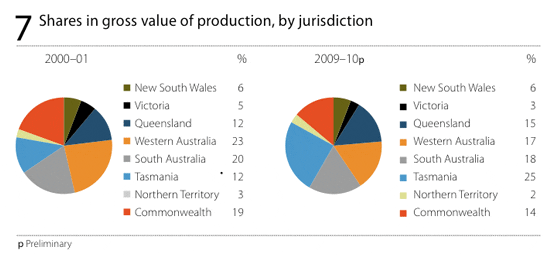
By location of catchwhere Commonwealth catch is distributed to the states according to where it was caughtTasmania accounted for the largest share (27 per cent), followed by Western Australia (21 per cent), South Australia (19 per cent) and Queensland (17 per cent) (figure 8).

Production by sector
The gross volume and value of Australian production, by sector, is given in table 1. Production and value summaries for each sector are given in table 2 (wild-catch sector) and tables 15 to 17 (aquaculture sector).
In 200910, the total volume of Australian fisheries production increased by two per cent (3615 tonnes) to 241 123 tonnes. This increase was mainly the result of higher production in the aquaculture sector, which rose by five per cent (3449 tonnes), offset by a one per cent (921 tonnes) decrease in the production volume of the wild-catch sector.
The gross value of Australian fisheries production fell by two per cent (A$35.4 million) from A$2.21 billion in 200809 to A$2.18 billion in 200910. The gross value of wild-catch production fell by A$48.2 million to A$1.34 billion, while the gross value of aquaculture production fell by A$3.8 million to A$870.4 million.
From 200001 to 200910, the value of state wild-catch production decreased by A$700 million (41 per cent) in real terms (figure 9). The value of aquaculture production decreased to a lesser extent, by A$40.2 million (four per cent), over the same period. The value of Commonwealth fisheries production also declined, by A$297.5 million (48 per cent) from A$614.3 million in 200001 to A$316.7 million in 200910.
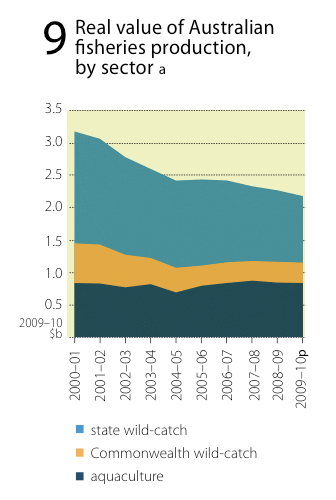
Wild-catch (table 2)
Key species groups: prawns, rock lobster, tuna and abaloneIn 200910, the total production volume of the wild-catch sector declined by 921 tonnes (one per cent) to 171,512 tonnes. Declines in production volumes occurred across crustacean and mollusc groups, declining by two per cent and five per cent, respectively. Fish production increased (557 tonnes) between 200809 and 200910 to reach 118,943 tonnes. In value terms, the gross value of wild-catch production fell by three per cent (A$48.2 million) to A$1.34 billion in 200910, driven by a three per cent decrease in the average unit value for product landed by the sector (figure 10).
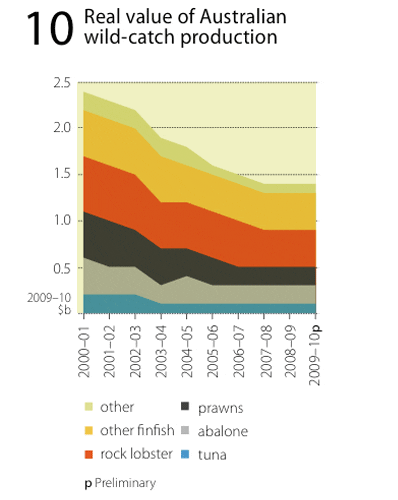
The value of fish production fell by four per cent (A$18.2 million) to A$446.7 million in 200910. Declines in production volumes for high-valued products, such as tuna and coral trout, were key drivers behind the decrease in the value of wild-caught fish production. This resulted in the value of production for tuna and coral trout declining by 21 per cent (A$15.2 million) and 16 per cent (A$6.1 million), respectively; a decrease in production volume and value for sharks, by 19 per cent (1631 tonnes, $6.7 million), also contributed. In contrast, the production value for Australian sardine increased by 26 per cent (A$5.5 million) to A$26.3 million in 200910 as a result of a 29 per cent (9079 tonnes) increase in its production volume. The production value for mullet also increased by A$3.3 million (30 per cent) as a result of a 33 per cent (1375 tonnes) increase in production volume between 200809 and 200910.
The value of mollusc production fell by A$9.4 million (four per cent) to A$205.6 million between 200809 and 200910. Abalone and scallop production accounted for 89 per cent of this value. Despite a five per cent increase in the average unit value, the value of wild-caught abalone fell by four per cent (A$7.3 million). A nine per cent decrease in the production volume was a key driver. The value of scallop production, which accounted for 13 per cent of total mollusc production, also fell by one per cent (A$0.4 million) to A$25.8 million in 200910.
The value of crustacean production fell by three per cent (A$22.8 million) to A$687 million in 200910 compared with 200809. Rock lobster and prawn production accounted for the major share (90 per cent) of the total value of wild-caught crustacean production in 200910. The production volume of rock lobster decreased by 20 per cent (2417 tonnes) to 9628 tonnes in 200910, while the value decreased by only 10 per cent (A$42 million) to A$368.8 million, because of a 12 per cent increase in average unit prices for rock lobster. In contrast, the value of prawn production rose by six per cent (A$13.4 million), and its volume of production increased by seven per cent (1452 tonnes).
Since 200001, the gross value of wild-catch production decreased by 43 per cent (A$997.5 million) in real terms. Falls occurred across all major wild-caught species over this period. The largest declines occurred for prawns (A$273.6 million), rock lobster (A$253.9 million), abalone (A$194.2 million) and tuna (A$101.8 million), and were the combined result of declines in unit prices and production volumes.
Aquaculture (tables 1517)
Key species groups: prawns, oyster, tuna, salmonidsThe gross value of aquaculture production remained relatively stable in 200910, increasing by A$3.8 million to A$870.4 million compared with 200809 (figure 11). Prawns, tuna, salmonids, edible oysters and pearl oysters accounted for 87 per cent of this value, contributing A$753 million in 200910.
The largest contributor to Australian aquaculture production is salmonids, making up 43 per cent and 42 per cent of the total aquaculture production volume and value, respectively. The production value of farmed salmonids rose by A$43 million (13 per cent) between 200809 and 200910, to A$369.1 million. The increase in salmonids value was driven by a six per cent (1879 tonnes) increase in production volume and seven per cent increase in unit value. Most salmonids production occurred in Tasmania. Rapid growth of this species group in Tasmania since 200506 has contributed significantly to expansion of Australian salmonids production. Compared with 200405, the real value of Australian farmed salmonids production increased by 117 per cent (A$198.9 million). The volume of production also increased considerably, by 87 per cent (14,852 tonnes) over the same period.
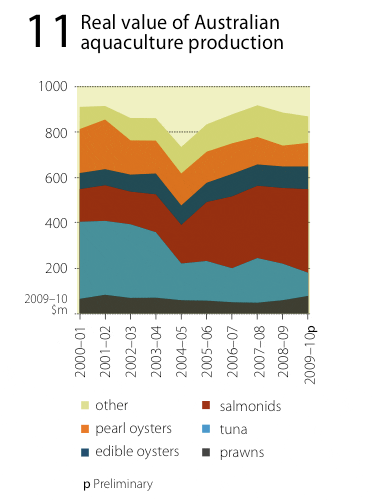
Farmed tuna production consists solely of farmed southern bluefin tuna from South Australia, which accounted for 12 per cent of the total value of Australian aquaculture production in 200910. The value of farmed tuna production fell by $55.6 million (35 per cent) between 200809 and 200910 to A$102.2 million because of a 17 per cent fall in production (to 7284 tonnes) and a 22 per cent decline in average unit prices.
Aquaculture prawns accounted for nine per cent of the total value of Australian aquaculture production in 200910. This species group also increased in value by A$20.6 million (36 per cent) between 200809 and 200910 because of a 35 per cent increase in production volume. Most of the increase in farmed prawn production in 200910 occurred in Queensland where the volume of aquaculture prawn production increased by 37 per cent (1395 tonnes) to 5216 tonnes.
Since 200001, the gross value of aquaculture production has declined by four per cent (A$40.2 million) in real terms, predominantly because of a A$237.7 million decrease in the real value of tuna production. A decline in the value of pearl aquaculture production, by A$89.4 million in real terms between 200001 and 200910, was also a key factor.


